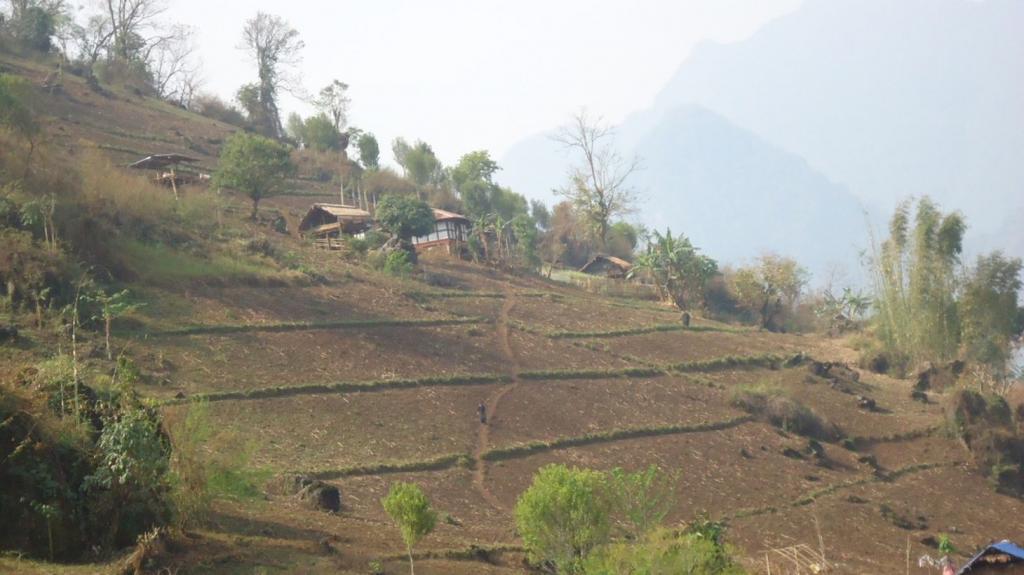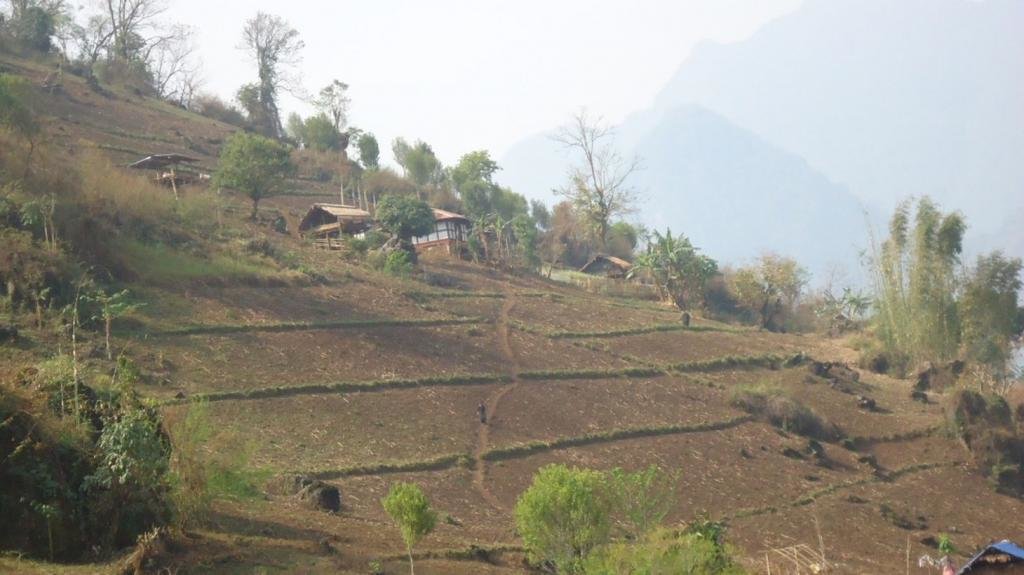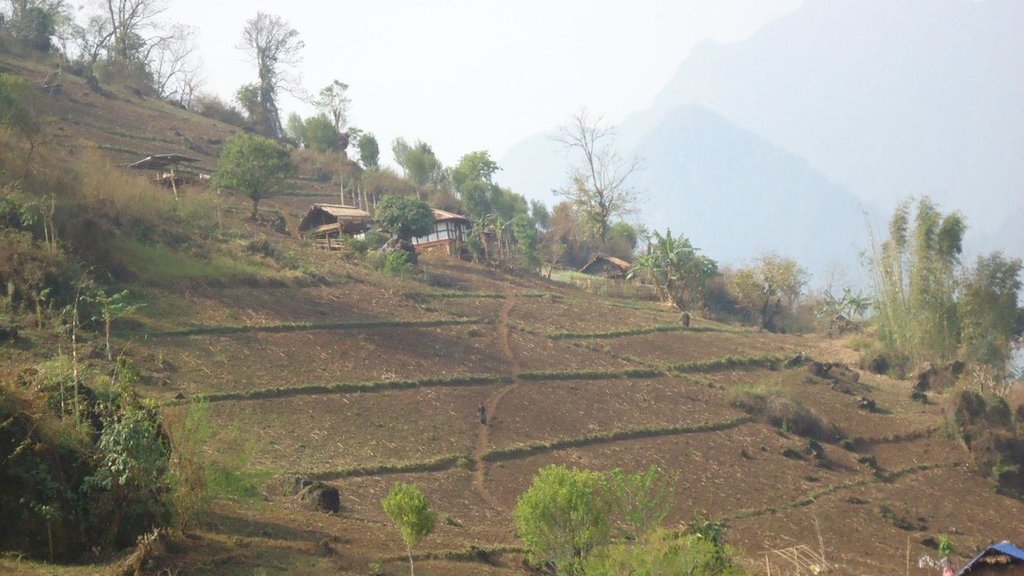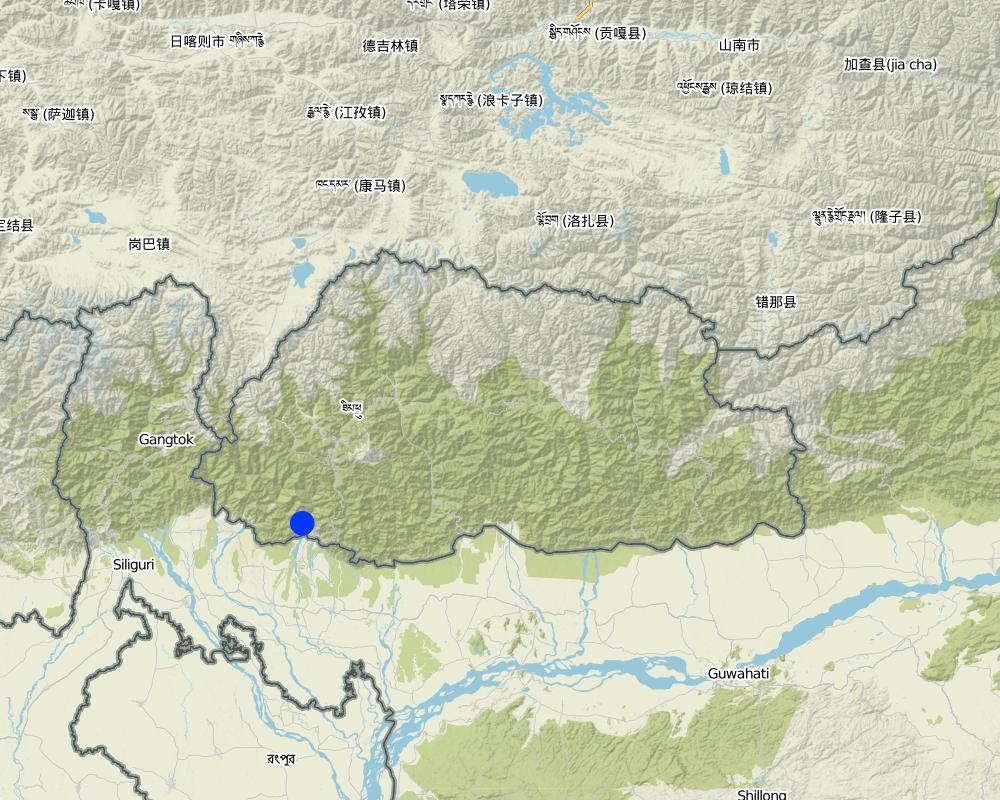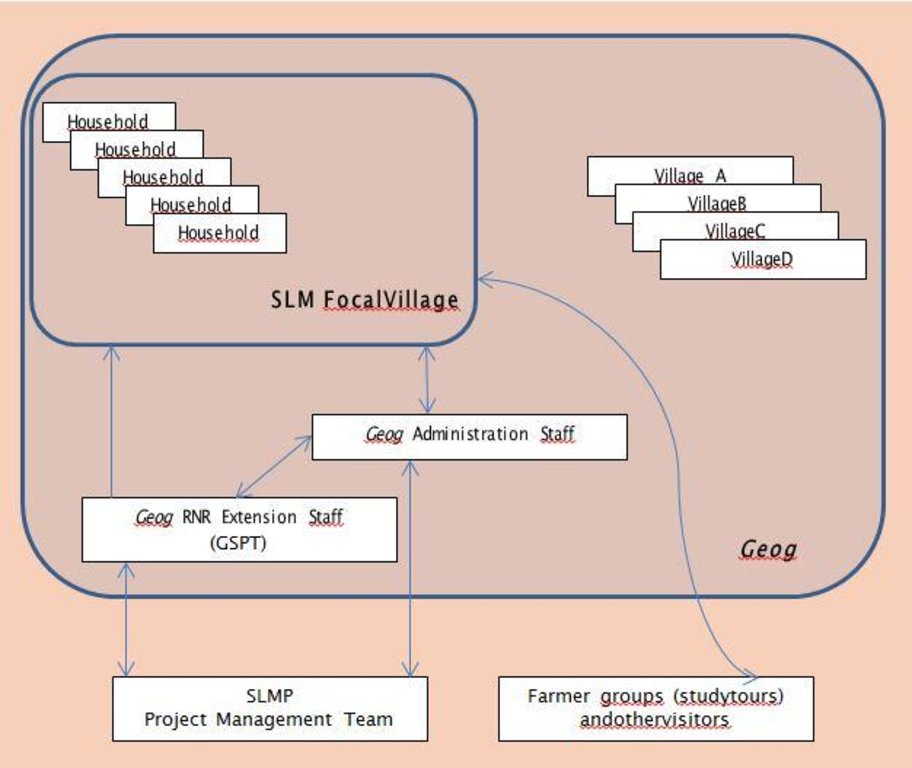SLM Focal Village [Бутан]
- Создание:
- Обновить:
- Составитель: Karma Dorji
- Редактор: –
- Рецензент: Fabian Ottiger
approaches_2490 - Бутан
Просмотреть разделы
Развернуть все Свернуть все1. Общая информация
1.2 Контактные данные специалистов и организаций, участвующих в описании и оценке Подхода
Название организации (-ий), содействовавших документированию/оценке Подхода (если применимо)
MoA (MoA) - БутанНазвание организации (-ий), содействовавших документированию/оценке Подхода (если применимо)
National Soil Services Centre (National Soil Services Centre) - Бутан1.3 Условия, регламентирующие использование собранных ВОКАТ данных
Когда были собраны данные (на местах)?
20/03/2011
Составитель и ответственный/-ые специалист(-ы) согласны с условиями, регламентирующими использование собранных ВОКАТ данных:
Да
1.4 Ссылка (-и) на Анкету (-ы) по Технологиям УЗП
2. Описание Подхода УЗП
2.1 Краткое описание Подхода
Focused support to a single village community to promote the widespread integrated implementation of SLM interventions.
2.2 Подробное описание Подхода
Подробное описание Подхода:
Aims / objectives: A SLM Focal Village is an approach to focus support to a particular village where a whole range of integrated SLM interventions is showcased in order to create visual impact and to serve as a demonstration site. The concept of a SLM Focal Village was developed in order to tackle the concern of dilution of impact caused by inclusion of all the villages and the households that are geographically very scattered and dispersed. Focal villages are selected at geog (block) level based on their accessibility, visibility for visitors and passers-by, severity of land degradation issues and interest shown by the village community.
Methods: Participatory SLM Action Planning is used to identify land-based problems, their causes and to discuss, select and prioritize specific targeted SLM interventions into a chiog (village) SLM action plan. Additional support is given to the village community to convert larger complexes of clustered land to more sustainable use with locally suited SLM practices. Popular interventions are stone bunding, grass hedgerows, bench terracing, bamboo and tree plantation and fodder development. The for-mation of labour-sharing groups is promoted in the SLM Focal Villages to ease high labour requirement for some SLM activities.
Stages of implementation: Where possible, integrated approaches are adopted, linking increasing vegetative cover of degraded or vulnerable areas with fodder development in marginal slope segments. FYM shed construction is combined with breed improvement and transition to stall feeding, providing manure for cropland. The SLM Focal Villages are used as demonstration sites and interested farmer groups on study tours and other visitors can get a quick impression of a variety of SLM activities showcased in a limited geographical area.
Role of stakeholders: The SLM Focal Villages are used as demonstration sites and interested farmer groups on study tours and other visitors can get a quick impression of a variety of SLM activities showcased in a limited geographical area.
Other important information: SLM Focal Villages require more guidance and monitoring by local extension staff and relatively higher budgets as the areas of land converted to SLM practices are often larger and thus related expenses for seeds, seedlings and other incentives like tools. In some focal villages additional labour-saving machinery is supplied, for example maize flour mill, oil expeller, rice huller, cornflake machine, etc. as an incentive to the community for taking up SLM interventions on comparatively larger scale..
2.3 Фотографии, иллюстрирующие Подход
2.5 Страна/ регион/ место, где применялся Подход
Страна:
Бутан
Административная единица (Район/Область):
Chhukha Dzongkhag
Более точная привязка места:
Phuntsholing geog, Serina chiog
Map
×2.6 Даты начала и окончания реализации Подхода
Год начала реализации:
2009
Год окончания (Если Подход больше не применяется):
2012
2.7 Тип Подхода
- в рамках проекта/ программы
2.8 Каковы цели/ задачи Подхода
The Approach focused mainly on SLM with other activities (Advocay of implementation of various SLM techniques through focus village (chiog) approach)
- Creating a visible and tangible impact at chiog level through widespread implementation of SLM technologies
- Convert present fallow land and former slash-and-burn practice areas to more sustainable cropland with an improved fodder base
- Improve community sense and enhance sustainability of SLM approaches through group support
The SLM Approach addressed the following problems: - Inclusion of all households at village level in a large and geographically dispersed geog leads to dilution of (visual) impact and benefits.
- Targeting individual households makes it more difficult to create a focused demonstration area to showcase SLM interventions at village level
2.9 Условия содействующие применению Технологии/ Технологий в рамках Подхода или затрудняющие его
Институциональные условия
- затрудняют
Transition of focus from individual household approach to labour-sharing approach, uniting lager groups of community members
Treatment through the SLM Approach: Group support, targeted training and guidance/monitoring
Нормативно-правовая база (землевладение, права на земле- и водопользование)
- содействуют
The existing land ownership, land use rights / water rights greatly helped the approach implementation: Individual titled land tenure greatly help implementation of SLM activities as the land users have great commitment and feeling of ownership, getting direct benefits and leading in decision-making process.
Объем работ, доступность рабочей силы
- затрудняют
Larger areas to be treated with SLM interventions requires substantial work load of all households
Treatment through the SLM Approach: Labour-sharing groups to ease labour constraint and promote/enhance community bonding/sense
другие
- затрудняют
Lack of direct tangible impact of long-term SLM interventions
Treatment through the SLM Approach: Combining long-term SLM activities with short-term inputs and incentives and additional capacity building / awareness raising
3. Участие и распределение ролей заинтересованных сторон
3.1 Заинтересованные стороны, участвующие в реализации Подхода и их роли
- местные землепользователи/ местные сообщества
Serina chiog community
Households from vulnerable groups (lower “well-being class” after chiog “well-being ranking”) are involved as much as possible in SLM interventions.
- эксперты по УЗП/ сельскому хозяйству
- местные власти
Dzongkhag, geog and chiog administration together with the RNR extension staff and GSPs
- государственные власти (отвечающие за планирование или принятие решений)
RGoB, MoAF, DoA, NSSC, SLMP
- международные организации
Если участвовало несколько заинтересованных сторон, назовите ведущую организацию:
developed as result of internal review of project progress and impact
3.2 Участие местных землепользователей/ местных сообществ на разных стадиях реализации Подхода
| Участие местных землепользователей/ местных сообществ | Перечислите участников и опишите их вовлеченность | |
|---|---|---|
| инициирование/ мотивация | интерактивное | Initial meetings to sensitize farmers and to create awareness of SLM issues |
| планирование | интерактивное | Participatory SLM action planning at chiog level; annual planning cycle, repeated for 3 years |
| выполнение | интерактивное | Based on the chiog SLM action plan SLM interventions are implemented with input support and incentives; guidance and capacity building by municipality extension staff and geog SLM planners |
| мониторинг/ оценка | интерактивное | Participatory Monitoring & Evaluation meetings carried out by geogSLM planning team (GSPT) |
| Research | нет |
3.3 Схема реализации (если имеется)
Описание:
SLM focal village and its linkage with support providers
Автор:
Hans van Noord (Schoutenkamp 43 Heteren The Netherlands)
3.4 Принятие решений по выбору Технологии/ Технологий УЗП
Укажите, кто принимал решение по выбору применяемой Технологии/ Технологий:
- в основном землепользователи при поддержке специалистов по УЗП
Поясните:
the annual participatory SLM Action Planning is key approach used to identify and prioritize SLM technologies for implementation at village level.
Decisions on the method of implementing the SLM Technology were made by mainly by SLM specialists with consultation of land users. based on the SLM Action plan for the village and amended, if necessary, by the findings of M&E meetings
4. Техническая поддержка, повышение компетенций и управление знаниями
4.1 Повышение компетенций/ обучение
Проводилось ли обучение землепользователей/ других заинтересованных лиц?
Да
Укажите, кто проходил обучение:
- землепользователи
Если существенно, укажите гендерный и возрастной состав, статус, этническую принадлежность и т.д.
Whole community involved with SLM: inclusive approach to all 44 households
Тип обучения:
- обмен опытом между фермерами
- опытные участки
- общие собрания
Рассматриваемые темы:
A series of awareness raising activities related to identification of local land-based problems, its causes and possible SLM interventions through an annual SLM action planning and following implementation. This is combined with specific technical trainings focused on the SLM activities prioritized in the village SLM action plan.
4.2 Консультационные услуги
Есть ли у землепользователей возможность получать консультации?
Да
Укажите, где именно оказываются консультационные услуги:
- на полях землепользователей
Описание/ комментарий:
Name of method used for advisory service: Field visits and meetings; Key elements: technical guidance, awareness raising and group formation support
Advisory service is inadequate to ensure the continuation of land conservation activities
4.3 Институциональная (организационная) поддержка
В ходе реализации Подхода были ли организованы новые институциональные структуры или поддержаны уже существующие?
- да, умеренно
Укажите уровень, на котором структуры были укреплены или вновь созданы:
- местные
Укажите тип поддержки:
- финансовая
- повышение компетенций/ обучение
- оборудование
Подробнее:
Yes, SLM focal village development is a direct form of local institution support.
4.4 Мониторинг и оценка
Являются ли мониторинг и оценка частью Подхода?
Да
Комментарии:
bio-physical aspects were ad hoc monitored by project staff, land users through observations; indicators: terrace area increase and area treated with stone bunds
bio-physical aspects were ad hoc monitored by project staff, land users through measurements; indicators: terrace area increase and area treated with stone bunds
technical aspects were regular monitored by project staff, land users through observations; indicators: Regular observations by project staff with land users of specific SLM interventions: progress, problems, areas for improvement
socio-cultural aspects were regular monitored by project staff, land users through observations; indicators: Regular observations on community / focal village approach through participatory M&E meetings; community sense, conflicts etc.
economic / production aspects were regular monitored by project staff, land users through measurements; indicators: Regular measurements by project staff and land users: crop yields, income, fodder and animal production
area treated aspects were regular monitored by project staff, land users through measurements; indicators: Regular measurements by project staff and land users: area of SLM interventions (hedgerows, stone bunds, bench terraces, # of check dams tec.)
no. of land users involved aspects were regular monitored by project staff, land users through measurements; indicators: Regular measurements by project staff and land users: number of households participating in each specific training and event (male/female)
management of Approach aspects were regular monitored by project staff, land users through observations; indicators: Regular observations by project staff and land users during participatory M&E meetings; ad hoc meetings with project management staff
There were few changes in the Approach as a result of monitoring and evaluation: Adjustment of technical interventions due to farmer feedback during participatory M&E meetings; review of annual SLM action plan leads to readjusted action plans based on evaluation with community on progress and issues.
There were few changes in the Technology as a result of monitoring and evaluation: Adjustment of technical interventions due to farmer feedback during participatory M&E meetings; review of annual SLM action plan leads to readjusted action plans based on evaluation with community on progress and issues.
5. Финансирование и внешняя материальная поддержка
5.1 Годовой бюджет мероприятий по УЗП в рамках Подхода
Если точный годовой бюжет неизвестен, укажите примерный диапазон затрат:
- 10000-100000
Комментарий (например, основные источники финансирования/ ключевые доноры):
Approach costs were met by the following donors: international (World Bank GEF): 60.0%; government (RGoB): 20.0%; local community / land user(s): 20.0%
5.2 Финансирование и внешняя материальная поддержка, предоставляемая землепользователям
Предоставлялась ли землепользователям финансовая/ материальная поддержка для применения Технологии /Технологий?
Да
5.3 Субсидии на отдельные затраты (включая оплату труда)
- оборудование
| Укажите, какие ресурсы были субсидированы | В какой степени | Опишите субсидии подробнее |
|---|---|---|
| maize floor mill, green net sheds, water drums | профинансированы частично | |
- сельскохозяйственные
| Укажите, какие ресурсы были субсидированы | В какой степени | Опишите субсидии подробнее |
|---|---|---|
| семена | профинансированы полностью | maize, paddy, vegetables |
- строительные материалы
| Укажите, какие ресурсы были субсидированы | В какой степени | Опишите субсидии подробнее |
|---|---|---|
| CGI sjeets, water drums and houses | профинансированы полностью | |
- другие
| Другой (какой именно) | В какой степени | Опишите субсидии подробнее |
|---|---|---|
| incentive payment | профинансированы частично | per unit area of hedge row and stone bunding |
Если труд землепользователя был существенным вкладом, укажите, был ли этот вклад:
- добровольный
Комментарии:
Labour is mainly voluntary contribution by household, but partly compensated with cash and other material support for the more labour-intensive interventions such as stone bunding and hedgerow establishment; labour-saving groups also supported with tool sets
Tool sets partly financed; seeds and seedlings mostly fully financed; CGI sheets, green net and drums for FYM sheds, green net sheds and water collection drums fully financed; some labour-saving machinery fully financed such as maize flour mill as community incentive.
5.4 Кредитование
Предоставлялись ли в рамках Подхода кредиты на мероприятия УЗП?
Нет
6. Анализ влияния и заключительные положения
6.1 Влияние Подхода
Сумел ли Подход помочь землепользователям внедрить и поддерживать технологии УЗП?
- Нет
- Да, немного
- Да, умеренно
- Да, существенно
Increased area under SLM treatment with improved fodder availability and formation of SLM related groups (labour-saving group etc.); former slash-and-burn practice area now converted into more sustainable land use; water sources protected and degraded areas afforested.
Сумел ли Подход разрешить правовые проблемы землевладения/ землепользования, препятствующие использованию технологий УЗП?
- Нет
- Да, немного
- Да, умеренно
- Да, существенно
Absentee land owners can complicate a full coverage of SLM interventions. The problem is unlikely to be overcome in the near future. Land ownership is a private matter, which is difficult to change land use without permission of abent land owner
Did other land users / projects adopt the Approach?
- Нет
- Да, немного
- Да, умеренно
- Да, существенно
Did the Approach lead to improved livelihoods / human well-being?
- Нет
- Да, немного
- Да, умеренно
- Да, существенно
In terms of increased yield, improved fodder availability and quality and increased production area; enhanced community bonding through group activities and related easing of labour constraints (labour-saving groups).
Did the Approach help to alleviate poverty?
- Нет
- Да, немного
- Да, умеренно
- Да, существенно
Through inclusion in labour-sharing groups labour constraint of vulnerable households addressed. Focus of hands-on training on land of most vulnerable households to give them first benefit and ensure inclusion.
6.2 Основные причины, побуждающие землепользователей внедрять УЗП
- рост продуктивности
Small immediate increase, but good increase in long-term
- рост прибыли (доходности) и рентабельности
- снижение объёма работ
labour-sharing groups: Reduced workload through improved land (with hedgerows, stone b
- материальное стимулирование/ субсидии
incentives and inputs
- нормативно-правовое регулирование (штрафы)/ контроль
enforcement through GSPT/community
- экологическая сознательность
environmental awareness
- well-being and livelihoods improvement
wish to improve food self-sufficiency and increase of continuous cropping area
6.3 Долгосрочная устойчивость мероприятий в рамках Подхода
Могут ли землепользователи самостоятельно (без внешней поддержки) продолжать применение того, что было реализовано в рамках Подхода?
- да
Если да, опишите как:
Village communities express commitment to continue focal village approach, but it remains to be seen if they actually are able to continue with various SLM activities without support post-project. The communities are intending to continue to convert ex slash-and-burn area to annual cropland, making use of labour-sharing group. This old traditional system is rejuvenated and therefore is more likely to be sustainable post-project.
6.4 Сильные стороны/ преимущества Подхода
| Сильные стороны/ преимущества/ возможности по мнению землепользователей |
|---|
|
reduced dependency on forest and tseri (How to sustain/ enhance this strength: maintenance of new annual crop land ) |
| more annual cropland through SLM interventions (How to sustain/ enhance this strength: maintenance of new annual crop land) |
|
better workability of developed cropland (stone bunding / hedgerows etc.) (How to sustain/ enhance this strength: maintenance of new annual crop land) |
| short-term inputs and subsidies enable the poorer households to take up log-term SLM interventions (How to sustain/ enhance this strength: targeted support to vulnerable households to maintain an inclusive approach) |
| Сильные стороны/ преимущества/ возможности по мнению составителя или других ключевых специалистов |
|---|
|
Holistic integrated village development enabling to showcase a variety of SLM interventions (How to sustain/ enhance this strength: Regular technical guidance and targeted capacity building efforts ) |
| Enables to convert larger areas of previous fallow land, or previously under slash-and-burn practice, to more sustainable cropland and reduces dependency on forest and slash-and-burn (How to sustain/ enhance this strength: Regular technical guidance and targeted capacity building efforts, combined with input support and guidance of labour-saving groups) |
| Pressure on communities to change land-use through governmental rule to stop slash-and-burn practice makes them very interested in adopting SLM (How to sustain/ enhance this strength: Regular technical guidance and targeted capacity building efforts, combined with short-term incentives) |
| Group formation process enables labour-sharing approach, which is very well appreciated (How to sustain/ enhance this strength: Regular technical guidance and targeted capacity building efforts) |
6.5 Слабые стороны/ недостатки Подхода и пути их преодоления
| Слабые стороны/ недостатки/ риски по мнению землепользователей | Возможные пути их преодоления/снижения? |
|---|---|
| Increase of work load combined with demand for labour of other developmental activities (rural water supply, road construction etc.). Therefore 'underperformance' against set targets | Better seasonal planning, try to avoid busy agricultural season. |
| Слабые стороны/ недостатки/ риски по мнению составителя или ответственных специалистов | Возможные пути их преодоления/снижения? |
|---|---|
| Risk of dependency on incentives/inputs: spoon-feeding syndrome |
Continued support to community and labour-saving groups to support land conversion efforts |
|
Focus and concentration of efforts to one community might cause dissatisfaction among neighbouring villages |
Continue SLM support to other villages as planned; communicate reasons of selection clearly: transparency at municipality level. |
| Requires considerable input of labour by community, but clashes with other requirement of developmental activities such as drinking water supply, irrigation channel construction, electrification and farm road construction | Labour-sharing group to ease labour constraint |
7. Справочные материалы и ссылки
7.1 Методы сбора/источники информации
- выезды на места, полевые обследования
- опросы землепользователей
Ссылки и модули
Развернуть все Свернуть всеСсылки
Нет ссылок
Модули
Нет модулей


